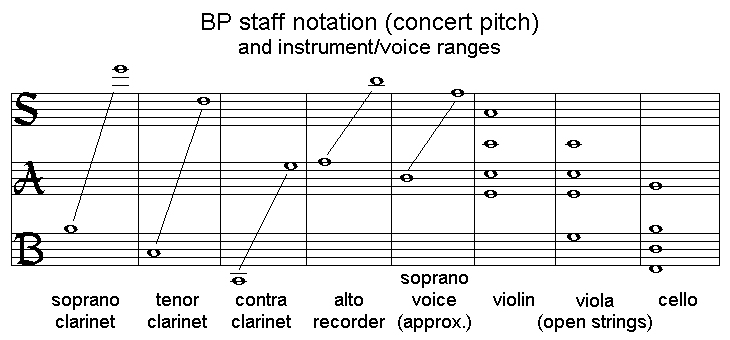|
|
|
|
|
|
|
|
|
|
|
|
|
|
The instruments used in music based on the Bohlen-Pierce scale have until recently been designed and built by a very few performers, and have not been heard extensively in public. The earlier instruments were an electronic synthesiser, and acoustic and electric guitars (see the website maintained by Heinz Bohlen).
The current activity of tranSpectra and of the group based at the Hochschule für Musik und Theater Hamburg uses a number of newly developed and adapted instruments, some of which are described below.

The first of the new Bohlen-Pierce instruments is the clarinet, designed and constructed by Stephen Fox, at the suggestion of Dr. Georg Hajdu, composer and professor at the Hochschule für Musik und Theater Hamburg. For complete information on this project, see here.
A family of at least three clarinet-type instruments - soprano (the same size as the normal Bb clarinet), tenor (six BP scale steps below the soprano, between the conventional alto and bass) and contra (a twelfth below the soprano, i.e., the same size as the normal Eb contrabass) - is planned, though most attention so far has been concentrated on the soprano.
The clarinet’s characteristic of overblowing at the twelfth, and the larger scale steps compared with the traditional 12 tone scale, mean that the Bohlen-Pierce clarinet is considerably simpler mechanically than conventional woodwinds. The low notes are handled by mechanism functioning the same way as the arrangement on the Boehm system clarinet; the rest of the tritave is produced by six open finger holes and a thumb hole - with no keywork necessary - and a left hand first finger key analogous to the normal clarinet throat A key. The second register is produced by a simple speaker key, and there is one trill key (not essential but useful). The fingering pattern is likewise very simple, with no fork fingerings necessary below the altissimo register. In terms of mouthpiece and tone production technique, the instrument is played in the same way as a conventional clarinet, except of course that the player needs to relearn how to “think” the notes and intervals in tune.
The chart below gives fingerings, frequencies and the comparison with conventional tuning of the notes of the scale for the BP clarinets.
To
date, four BP soprano clarinets have been completed, two of which were
delivered in 2007 to Dr. Georg Hajdu in Hamburg, with the other two remaining
in Canada, and more are on order.
|
(lowest overblown note 440Hz; same size as conventional Bb clarinet) |
||||||
|
||||||
|
||||||
|
BP clarinet notation
While numerous methods of notating music for the BP clarinets are conceivable, with varying degrees of "correctness", one very practical option is simply to transfer the same staff positions and written note symbols used with the conventional clarinet, to the analogous fingerings* on the BP clarinet:
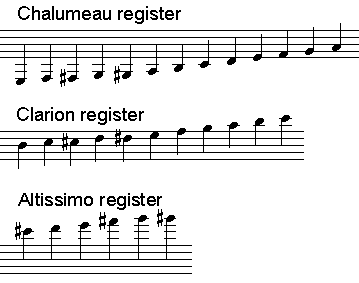
This notation admittedly has very little to do with the pitches produced, but it has the advantage of making the technique of the new instruments as accessible as possible to clarinettists.
* Technically, the B in the chalumeau register should be called Bb based on the Boehm system fingering (or, alternatively, the F in the clarion register should be called F# based on the German system fingering), but since only one note in that register uses that name, the accidental would cause unnecessary clutter, so it can safely be omitted.
No clef is really necessary, but composers so far have automatically included the treble clef.
(A different notation system, in concert pitch and for all instruments, is described below and on the scale info page; at this point it is not yet clear which system will be used for BP clarinet parts in the future.)
The Bohlen-Pierce recorder
A recorder may be converted to the Bohlen-Pierce scale by plugging up the existing tone holes and drilling new holes at the appropriate locations.
Work so far has concentrated on the alto recorder, though the same principles can be extended to the other sizes.
Though various fingering arrangements are possible, the simplest is for the scale in the fundamental register to be produced by opening the holes in order, with no fork fingerings. The high register then works out conveniently, with the exception of one note, which requires a half hole (see below).
When tuning and playing the recorder, it needs to be remembered that the "octave" between the registers is smaller than a harmonic octave by about 30 cents.
For
the alto recorder, the hole positions are as follows:
|
|
||
|
* may
need to be moved up slightly and angled downwards, to stay away from junction
with foot joint
**
angled downwards at ~20° (theoretical location is 340.5mm); may be
drilled as a double hole, to facilitate the one note requiring a half hole
(see below)
Due
to differences in the bore among various recorders, no specific hole sizes
are given here; each hole should be drilled at approximately 5mm diameter,
then enlarged as necessary
|
(based on 440Hz) |
||||||
|
||||||
|
BP recorder notation
As with the BP clarinet, numerous methods of notating music are possible, but a simple solution is again to transfer the same staff positions and written note symbols used with the conventional recorder, to the analogous fingerings on the BP recorder. The notation given below shows the notes of the scale for the alto recorder (or other sizes normally pitched in F):
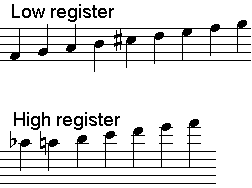
(A different notation system, in concert pitch and for all instruments, is described below and on the scale info page; at this point it is not yet clear which system will be used for BP recorder parts in the future.)
Any
number of tuned percussion instruments producing the Bohlen-Pierce scale
can be conceived, along the lines of existing instruments but with appropriately
resized tone generators. Two examples which have been constructed
so far are shown below:
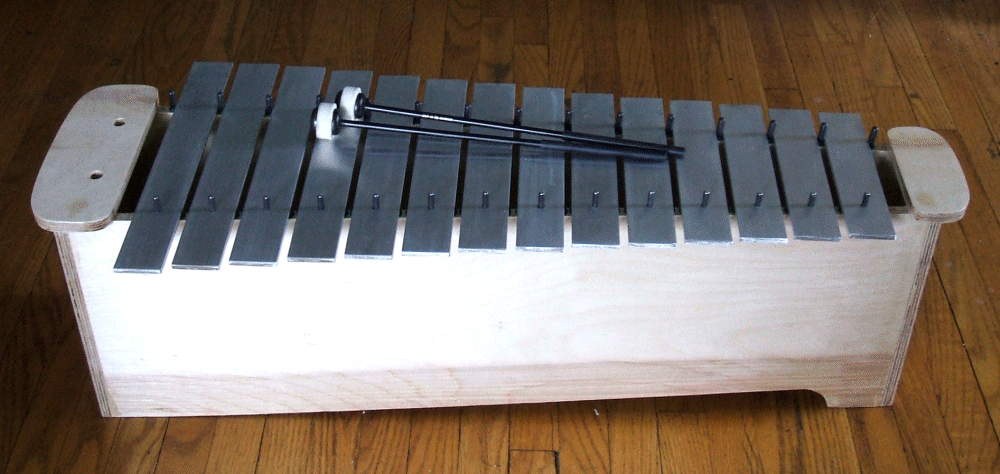
Bohlen-Pierce metallophone |
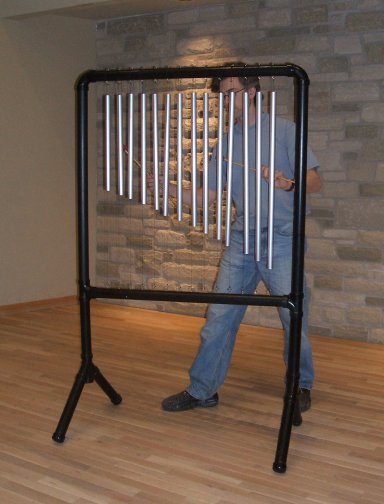
Bohlen-Pierce chimes |
Bowed
string instruments can be retuned to produce the Bohlen-Pierce scale, with
appropriate changes in finger stretch. The following scheme spaces
the strings in intervals of five Bohlen-Pierce scale steps, keeping each
string as close as possible to its conventional tuning:
| violin: | ||
| string name
E
|
frequency (Hz)
671.0
|
conventional pitch
E +
32¢
|
| viola: | ||
| string name
A
|
frequency (Hz)
440
|
conventional pitch
A
|
| cello: | ||
| string name
A
|
frequency (Hz)
223.8
|
conventional pitch
A +
30¢
|
In the general system of staff notation for notating Bohlen-Pierce scores and individual instrumental or vocal parts in concert pitch, as described on the scale info page of this site, the following gives the ranges of some instruments and voices (in addition to, or instead of, the pragmatic fingering-based notation systems for the clarinet and the recorder described above):
